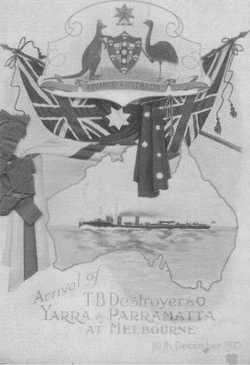- Author
- Periodical, Sea Power Centre
- Subjects
- History - general, Ship design and development
- Tags
-
- RAN Ships
- None noted.
- Publication
- June 2010 edition of the Naval Historical Review (all rights reserved)
Editor’s Note: This article first appeared in the Newsletter of the Sea Power Centre – Australia, dated February, 2007. We are grateful for the Centre’s permission to publish the article.
His Majesty the King has been graciously pleased to approve of the Permanent Naval Forces of the Commonwealth being designated the Royal Australian Navy (RAN), and of the ships of that Navy being designated His Majesty’s Australian Ships.
So begins Commonwealth Forces Navy Order number 77 of 1911, dated 5 October 1911. This order granted the title `Royal’ to Australia’s existing naval forces and formalised the use of the prefix ‘HMAS’ for all warships of the RAN. This prefix has changed only slightly from His Majesty’s Australian Ship, to Her Majesty’s Australian Ship when Elizabeth II became Monarch.
But what of the hundreds of ships’ names that have followed this prefix and adorned the cap ribbons of our sailors and WRANS since that time? How were these names selected? How might they be selected in the future? This Semaphore aims to answer these questions and provide the reader with an understanding of the evolution of the conventions used by the RAN when naming its vessels.
The first ships constructed for the Commonwealth Naval Forces, and thus the first Commonwealth naval vessels that required naming, were the three Torpedo Boat Destroyers (TBD) ordered by the Fisher Government in 1909.
In November 1909 the British Admiralty raised the question of naming the three destroyers and suggested that they be given names of Australian rivers. However, Senator Pearce, who was involved in the ordering of the ships, recommended naming them after eminent early Australian navigators. Prime Minister Alfred Deakin decided against this and subsequently accepted the Admiralty’s suggestion, with his Minister for Defence, Joseph Cook announcing that the three vessels would be known as Parramatta (I), Yarra (I) and Warrego (I) after Australian rivers bearing native names.

Cook’s announcement and preference for native river names reflected a distinct local identity and was an early acknowledgement of Australia’s Aboriginal heritage. Three more TBDs were built at Cockatoo Island to complete the RAN’s destroyer flotilla; however, Cook’s preference for using native river names was only partially followed, with the three additional destroyers being named Huon (I), Torrens (I) and Swan (I).
The process of gaining approval for ships’ names was adopted from policy established by the Royal Navy (RN) whereby proposed names were forwarded through the Admiralty to the King for his assent. In 1926 this policy was deviated from when the Admiralty was presented with proposed names for two Australian O class submarines. This was one of the first of the occasions that names had been submitted for submarines, which had hitherto been known by alpha numeric designations such as those given to the first Australian submarines AE1 and AE2. It transpired that as submarines were not considered `ships’ it would not be necessary to gain Royal assent. The `boats’ were subsequently named Oxley (I) and Otway (I) and on 22 June 1938 the Admiralty determined that only the names of fighting ships need be referred to His Majesty for approval.
On 7 February 1942 this policy was further revised when the Admiralty instructed that only names for ships classed as frigates or larger should receive Royal assent. This policy change came at a time when hundreds of ships and small craft were being requisitioned into war service throughout the Commonwealth with many of them retaining their original names. It was accepted that proposed names for Australian ships should continue to be referred to the Admiralty, although this was mainly to prevent duplication of names within Commonwealth navies. It was during this period that some of the RAN’s more colourful names came into being, with vessels such as Ping Wo, Whang Pu and Blowfly often raising people’s eyebrows when mentioned.
By adopting British naming principles the RAN continued the practice of naming large ships, such as aircraft carriers and cruisers, after major cities, and smaller ships, such as destroyers and frigates, after towns and rivers. The first RAN ships to bear the names of Australian capital cities were the three World War I Chatham class cruisers Sydney (I), Melbourne (I) and Brisbane (I), while the name of our great continent was reserved for the Indefatigable class battle cruiser, and first flagship of the RAN, Australia (I). As warship design and capability has evolved, so have the conventions for the allocation of names, and today it is the destroyers and frigates that proudly bear the names of our capital cities.




